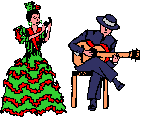|
Flamenco is an individualistic, yet structured folk art from Andalusia, which is often improvised
and spontaneous. The song, dance and guitar are blended together by the passionate rhythms of southern Spain which is flamenco's
geographical birthplace.
Gypsies say it's in the blood, but Spain's famous poet and writer Fredrico Garcia Lorca, called
flamenco one of the greatest inventions of the Spanish people. Some dare to disagree. Yet the tragic lyrics and tones of flamenco
clearly reflect the sufferings of the gypsy people.
|
|
 |
FLAMENCO | |
Flamenco is a genuine Spanish art, and to be more exact an genuine Southern Spanish art. It exists in
three forms: Cante, the song, Baile, the dance, and Guitarra, guitar playing.
Gypsies are very often
named as its fathers, and at least it can be taken for certain that they played an important part in its creation.
But also the popular songs and dances of Andalusia have influenced early Flamenco considerably.
Certainly there were other
influences, too, as it will not surprise in a country that has been dominated by most diverse cultures and civilizations during
its different historical epochs. There were the legendary Tartessos, and seven centuries of Muslim occupation hardly
could have passed without leaving traces. All that, directly or indirectly, influenced Flamenco.
The first time Flamenco
is reported on in literature is in the "Cartas Marruecas" of Cadalso, in 1774. Its cradle most probably was where,
between 1765 and 1860, the first Flamenco-schools were created: Cádiz, Jerez de la Frontera and Triana (Seville).
In this
epoch Flamenco dance started to have its firm position in the ballrooms. Early Flamenco seems to have been purely vocal, accompanied
only by rhythmical clapping of hands, toque de palmas. It was left to dedicated composers, as Julián Arcas, to introduce
guitar playing.
During its Golden Age (1869-1910) Flamenco was developed in the epoch's numerous music cafés
(cafés cantantes) to its definitive form. Also the more serious forms expressing deep feelings (cante jondo)
dates from then.
Flamenco dance arrived to its climax, being the major attraction for the public of those cafés
cantantes. Guitar players featuring the dancers increasingly gained a reputation.
The time from 1910 to 1955 Flamenco
singing is marked by the ópera flamenca, with an easier kind of music such as fandangos and cantes de ida
y vuelta. The latter clearly showed South American influences.
From 1915 on Flamenco shows were organized and performed
all over the world. Anyhow, not everybody was enchanted with that development and intellectuals such as Falla organized
1922 in Granada a contest to promote "authentical" cante jondo.
1955 started a sort of Flamenco Renaissance,
the great performer Antonio Mairena being its key figure. Outstanding dancers and soloists soon made their way out of the
small tablaos, successors to the early cafés cantantes, to the great theaters and concert houses. It was now
that guitar players acquired a great protagonism, and their playing arrived to masterity.
Actual Flamenco frequently
shows influences of other kinds of music, as Jazz, Salsa, Bossa Nova, etc.
Also Flamenco dance has changed, specially
female dancers try to rather showcase their temperament than artistry. The Flamenco guitar that formerly was just featuring
the dancers arrived to be a soloistical art form, great virtuoso Paco de Lucia being the pioneer of that development.
Mass
medias have brought Flamenco to the world stage, but deeply it has always been and will remain an intimate kind of music.
You have not listened authentical Flamenco if not in a juerga with a small group of friends, at midnight somewhere
in the South of Spain, when there is nothing around but the voice, the guitar and the body of a dancer moving in the moonlight.
|
|
 |
|



